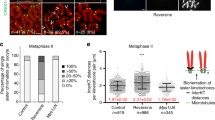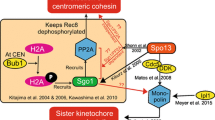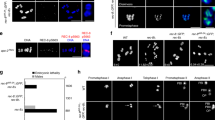Abstract
Maintenance and timely termination of cohesion on chromosomes ensures accurate chromosome segregation to guard against aneuploidy in mammalian oocytes and subsequent chromosomally abnormal pregnancies. Sororin, a cohesion stabilizer whose relevance in antagonizing the anti-cohesive property of Wings-apart like protein (Wapl), has been characterized in mitosis; however, the role of Sororin remains unclear during mammalian oocyte meiosis. Here, we show that Sororin is required for DNA damage repair and cohesion maintenance on chromosomes, and consequently, for mouse oocyte meiotic program. Sororin is constantly expressed throughout meiosis and accumulates on chromatins at germinal vesicle (GV) stage/G2 phase. It localizes onto centromeres from germinal vesicle breakdown (GVBD) to metaphase II stage. Inactivation of Sororin compromises the GVBD and first polar body extrusion (PBE). Furthermore, Sororin inactivation induces DNA damage indicated by positive γH2AX foci in GV oocytes and precocious chromatin segregation in MII oocytes. Finally, our data indicate that PlK1 and MPF dissociate Sororin from chromosome arms without affecting its centromeric localization. Our results define Sororin as a determinant during mouse oocyte meiotic maturation by favoring DNA damage repair and chromosome separation, and thereby, maintaining the genome stability and generating haploid gametes.




Similar content being viewed by others
References
Carretero M, Ruiz-Torres M, Rodriguez-Corsino M, Barthelemy I, Losada A (2013) Pds5B is required for cohesion establishment and aurora B accumulation at centromeres. EMBO J 32:2938–2949
Diaz-Martinez LA, Clarke DJ (2015) Sororin is tethered to cohesin SA2. Cell Cycle 14:1133
Eguren M, Manchado E, Malumbres M (2011) Non-mitotic functions of the anaphase-promoting complex. Semin Cell Dev Biol 22:572–578
Hara K, Zheng G, Qu Q, Liu H, Ouyang Z, Chen Z, Tomchick DR, Yu H (2014) Structure of cohesin subconplex pinpoints direct shugoshin-Wapl antagonism in centromeric cohesion. Nat Struct Mol Biol 21:864–870
Holubcová Z, Blayney M, Elder K, Schuh M (2015) Human oocytes. Error-prone chromosome-mediated spindle assembly favors chromosome segregation defects in human oocytes. Science 348:1143–1147
Huang CJ, Wu D, Khan FA, Huo LJ (2015a) DeSUMOylation: an important therapeutic target and protein regulatory event. DNA Cell Biol 34:652–660
Huang CJ, Wu D, Khan FA, Huo LJ (2015b) The SUMO protease SENP3 orchestrates G2-M transition and spindle assembly in mouse oocytes. Sci Rep 5:15600
Huang CJ, Wu D, Khan FA, Jiao XF, Guan KF, Huo LJ (2016) The GTPase SPAG-1 orchestrates meiotic program by dictating meiotic resumption and cytoskeleton architecture in mouse oocytes. Mol Biol Cell 27:1776–1785
Huis in ‘t Veld PJ, Herzog F, Ladurner R, Davidson IF, Piric S, Kreidl E, Bhaskara V, Aebersold R, Peters JM (2014) Characterization of a DNA exit gate in the human cohesin ring. Science 346:968–972
Jones KT, Lane SI (2013) Molecular causes of aneuploidy in mammalian eggs. Development 140:3719–3730
Khan FA, Pandupuspitasari NS, Huang CJ, Hao X, Zhang S (2015) SUMOylation: a link to future therapeutics. Curr Issues Mol Biol 18:49–56
Lane SI, Yun Y, Jones KT (2012) Timing of anaphase-promoting complex activation in mouse oocytes is predicted by microtubule-kinetochore attachment but not by bivalent alignment or tension. Development 139:1947–1955
Liu H, Jia L, Yu H (2013a) Phospho-H2A and cohesin specify distinct tension-regulated Sgo1 pools at kinetochores and inner centromeres. Curr Biol 23:1927–1933
Liu H, Rankin S, Yu H (2013b) Phosphorylation-enabled binding of SGO1-PP2A to cohesin protects sororin and centromeric cohesion during mitosis. Nat Cell Biol 15:40–49
Minamino M, Ishibashi M, Nakato R, Akiyama K, Tanaka H, Kato Y, Negishi L, Hirota T, Sutani T, Bando M, Shirahige K (2015) Esco1 acetylates cohesin via a mechanism different from that of Esco2. Curr Biol 25:1694–1706
Nagaoka SI, Hassold TJ, Hunt PA (2012) Human aneuploidy: mechanisms and new insights into an age-old problem. Nat Rev Genet 13:493–504
Nishiyama T, Ladurner R, Schmitz J, Kreidl E, Schleiffer A, Bhaskara V, Bando M, Shirahige K, Hyman AA, Mechtler K, Peters JM (2010) Sororin mediates sister chromatid cohesion by antagonizing Wapl. Cell 143:737–749
Nishiyama T.; Sykora M. M.; Huis in ‘t Veld P. J.; Mechtler, K.; Peters, J. M. aurora B and Cdk1 mediate Wapl activation and release of acetylated cohesin from chromosomes by phosphorylating sororin. Proc Natl Acad Sci U S A. 110: 13404–13409; 2013.
Oka Y, Varmark H, Vitting-Seerup K, Beli P, Waage J, Hakobyan A, Mistrik M, Choudhary C, Rohde M, Bekker-Jensen S, Mailand N (2014) UBL5 is essential for pre-mRNA splicing and sister chromatid cohesion in human cells. EMBO Rep 15:956–964
Peters JM (2012) The many functions of cohesin—different rings to rule them all? EMBO J 31:2061–2063
Peters JM (2014) Cohesin’s ATPase activity couples cohesin loading onto DNA with Smc3 acetylation. Curr Biol 24:2228–2237
Rolef Ben-Shahar T, Heeger S, Lehane C, East P, Flynn H, Skehel M, Uhlmann F (2008) Eco1-dependent cohesin acetylation during establishment of sister chromatid cohesion. Science 321:563–566
Sakakibara Y, Hashimoto S, Nakaoka Y, Kouznetsova A, Höög C, Kitajima TS (2015) Bivalent separation into univalents precedes age-related meiosis I errors in oocytes. Nat Commun 6:7550
Saloojee H, Coovadia H (2015) Maternal age matters: for a lifetime, or longer. The Lancet Global Health 3:e342–e343
Schmitz J, Watrin E, Lenart P, Mechtler K, Peters JM (2007) Sororin is required for stable binding of cohesin to chromatin and for sister chromatid cohesion in interphase. Curr Biol 17:630–636
Sundaramoorthy S, Vazquez-Novelle MD, Lekomtsev S, Howell M, Petronczki M (2014) Functional genomics identifies a requirement of pre-mRNA splicing factors for sister chromatid cohesion. EMBO J 33:2623–2642
Unal E, Heidinger-Pauli JM, Kim W, Guacci V, Onn I, Gygi SP, Koshland DE (2008) A molecular determinant for the establishment of sister chromatid cohesion. Science 321:566–569
Valcarcel J, Malumbres M (2014) Splicing together sister chromatids. EMBO J 33:2601–2603
van der Lelij P, Stocsits RR, Ladurner R, Petzold G, Kreidl E, Koch B, Schmitz J, Neumann B, Ellenberg J, Peters JM (2014) SNW1 enables sister chromatid cohesion by mediating the splicing of sororin and APC2 pre-mRNAs. EMBO J 33:2643–2658
Watrin E, Demidova M, Watrin T, Hu Z, Prigent C (2014) Sororin pre-mRNA splicing is required for proper sister chromatid cohesion in human cells. EMBO Rep 15:948–955
Whelan G, Kreidl E, Peters JM, Eichele G (2012a) The non-redundant function of cohesin acetyltransferase Esco2: some answers and new questions. Nucleus 3:330–334
Whelan G, Kreidl E, Wutz G, Egner A, Peters JM, Eichele G (2012b) Cohesin acetyltransferase Esco2 is a cell viability factor and is required for cohesion in pericentric heterochromatin. EMBO J 31:71–82
Yun Y, Lane SI, Jones KT (2014) Premature dyad separation in meiosis II is the major segregation error with maternal age in mouse oocytes. Development 141:199–208
Zhang N, Panigrahi AK, Mao Q, Pati D (2011) Interaction of sororin protein with polo-like kinase 1 mediates resolution of chromosomal arm cohesion. J Biol Chem 286:41826–41837
Acknowledgments
The present research has received the funding from National Natural Science Foundation of China (Grant No. 31071273 and 31171378) and Fundamental Research Funds for the Central Universities (Program NO. 2014PY045). C.J.H. and Y.F.Y. appreciate the support from State Key Laboratory of Agricultural Microbiology, Huazhong Agricultural University.
Author information
Authors and Affiliations
Corresponding author
Ethics declarations
Author contributions
C.J.H., Y.F.Y., and L.J. H conceived and designed the experiments; C.J.H. and Y.F.Y. performed experiments; C.J.H., D.W. and F.A.K analyzed the data; D.W., F.A.K., and X.F.J. contributed reagents/materials/analysis tools; C.J.H. and D. W wrote; and C.J.H., F.A.K., and L.J. H revised the paper.
Conflict of interest
The authors declare that they have no competing interests.
Additional information
Editor: Tetsuji Okamoto
Chun-Jie Huang and Yi-Feng Yuan equally contributed to this work.
Electronic supplementary material
Figure S1
Schematic diagram of step-wise loss of cohesion during meiosis in mouse oocytes. Cohesion (orange rings that entrap sister chromatids) in oocytes is established during pre-meiotic S phase of prophase I, which holds homologs together throughout the protracted prophase I arrest at dictyate stage. The “cohesive” cohesion is granted by recruitment of Sororin due to acetylation of Smc3 by Esco1/2 during S phase (the mechanism by which Sororin antagonizes Wapl-dependent anti-cohesive activity is boxed). Cleavage of cohesion on chromosome arms is conferred by mitotic kinases while its centromeric retention on sister chromatids is safeguarded by protein phosphatase 2 A (PP2A)-SGOL1 complex to entitle homologs to segregate as a syncytium during meiosis I. Release of centromeric cohesion on sisters is executed by separase to segregate sister chromatids during meiosis II. Precocious loss of centromeric cohesion during meiosis I and/or meiosis II will contribute to aneploidy in eggs, which leads to infertility, miscarriage, birth defects, and other reproductive/developmental disorders in human. (JPEG 2800 kb)
Rights and permissions
About this article
Cite this article
Huang, CJ., Yuan, YF., Wu, D. et al. The cohesion stabilizer sororin favors DNA repair and chromosome segregation during mouse oocyte meiosis. In Vitro Cell.Dev.Biol.-Animal 53, 258–264 (2017). https://doi.org/10.1007/s11626-016-0107-0
Received:
Accepted:
Published:
Issue Date:
DOI: https://doi.org/10.1007/s11626-016-0107-0




